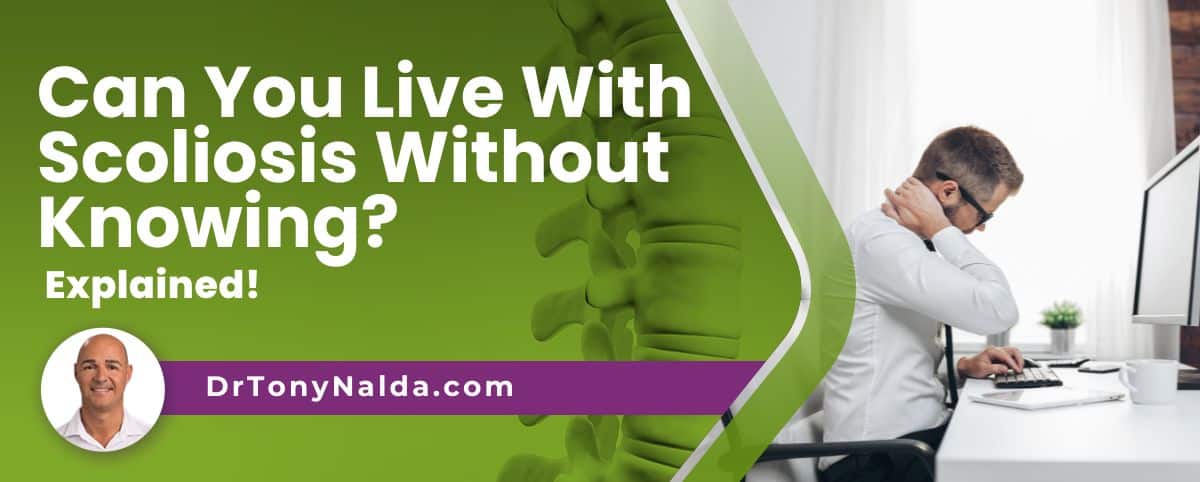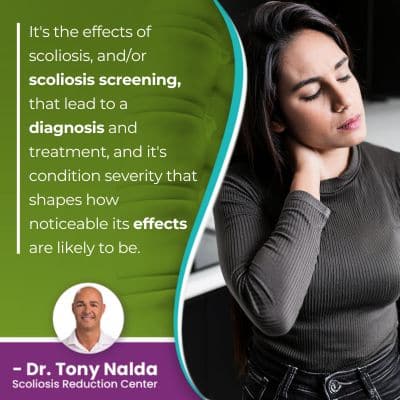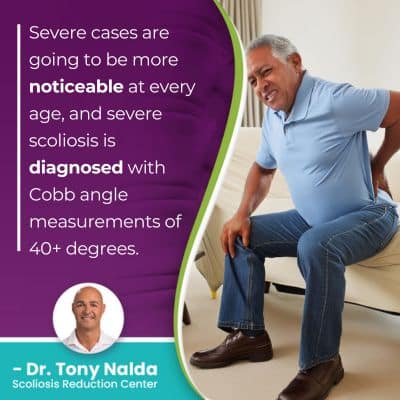Can You Live With Scoliosis Without Knowing? Explained!

Scoliosis ranges widely in severity, so symptoms of scoliosis experienced by some aren't always indicative of what others will face. Mild scoliosis can be hard to detect, particularly in children for whom the condition isn't commonly painful. Scoliosis becomes more noticeable the more severe it becomes, but the more severe it is, the more complex it is to treat.
Not only is it possible to live without knowing you have scoliosis, adolescents not being diagnosed or treated during adolescence is the main cause of adult scoliosis. It's easier for children to be unaware of scoliosis because scoliosis doesn't become compressive until adulthood.
Scoliosis is progressive and ranges widely from mild to severe; let's start with how condition severity is determined.
Table of Contents
From Mild to Severe: Determining Scoliosis Severity
For scoliosis to be diagnosed, an unnatural spinal curve that bends to the side and twists unnaturally has developed, and in addition, the size of the unnatural curve has to be a minimum of 10 degrees.
Part of diagnosing scoliosis involves further classifying conditions based on important variables such as patient age, condition type, curvature location, and condition severity.
Condition severity is a key piece of information that treatment plans are shaped around, and it's determined by a measurement known as Cobb angle.
X-ray imaging is necessary to diagnose scoliosis: to see what's happening in and around the spine, to confirm a rotational component, and to determine the Cobb angle.
A patient's Cobb angle is determined by drawing lines from the tops and bottoms of the curve's most-tilted vertebrae, and the resulting angle is expressed in degrees.
The higher a patient's Cobb angle, the more severe the condition; the more unnaturally tilted the vertebrae are, the more misaligned the spine is, and the more complex the condition will be to treat.
 With progression, the size of the unnatural spinal curve is increasing, as are the condition's uneven forces, and their effects, and in children, the most noticeable symptom is postural deviation, and in adults, it's pain.
With progression, the size of the unnatural spinal curve is increasing, as are the condition's uneven forces, and their effects, and in children, the most noticeable symptom is postural deviation, and in adults, it's pain.
Scoliosis ranges in severity from mild scoliosis to moderate scoliosis, severe and very severe scoliosis.
It's the effects of scoliosis, and/or scoliosis screening, that lead to a diagnosis and treatment, and it's condition severity that shapes how noticeable its effects are likely to be.
Mild Scoliosis Signs
As mild scoliosis has the most subtle effects, it's the most difficult to detect.
A diagnosis of mild scoliosis is given with a Cobb angle measurement of between 10 and 25 degrees, and as mild scoliosis involves small curves, it's the simplest to treat, but the benefits of early detection are only available to those whose diagnosis is met with a proactive treatment approach.
The signs of mild scoliosis can be subtle and difficult for anyone, other than a scoliosis expert who's trained in the condition, to recognize.
Particularly in children, it can be challenging to detect because scoliosis doesn't become a compressive condition until skeletal maturity has been reached, so for young patients whose spines are still growing, the condition isn't painful.
While no one wants to experience pain, it does serve a vital purpose of telling us something is wrong with the body.
So mild scoliosis isn't commonly painful until it becomes compressive, and the postural changes scoliosis causes can also be subtle at this level:
Most often, it's uneven shoulders and uneven hips that are the condition's earliest telltale signs.
So many children and adults can be living with scoliosis unaware, but it will be more common in children because scoliosis becomes painful in adulthood, which is the main symptom that brings adults in for a diagnosis and treatment.
Moderate Scoliosis Signs
Moderate scoliosis is diagnosed with a Cobb angle measurement of between 25 and 40 degrees.
The signs of moderate scoliosis are more noticeable than mild scoliosis; in fact, most of my patients are diagnosed with moderate scoliosis because it's common that once conditions have progressed from mild to moderate, they become noticeable.
The postural changes associated with moderate scoliosis can include:
- Uneven shoulders
- Uneven shoulder blades
- The development of a rib cage arch
- An uneven waist
- Arms and legs that appear to hang at different lengths
For adults, a prominent lean to one side, the aforementioned postural changes, and scoliosis pain are the signs of moderate scoliosis.
At the moderate severity level, the effects are more overt so are less likely to go unnoticed.
Severe Scoliosis
Severe cases are going to be more noticeable at every age, and severe scoliosis is diagnosed with Cobb angle measurements of 40+ degrees.
 At the severe level, children are likely to experience a degree of muscle pain, and back pain for adults can involve muscle pain, localized back pain, and pain that radiates into the extremities due to nerve compression.
At the severe level, children are likely to experience a degree of muscle pain, and back pain for adults can involve muscle pain, localized back pain, and pain that radiates into the extremities due to nerve compression.
When scoliosis is severe, it can affect a person's movement as the body's center of gravity is disrupted as the condition's uneven forces disrupt the body's overall symmetry.
Signs of severe scoliosis include overt postural changes and disruptions to balance, coordination, and gait.
When scoliosis is severe, it's likely to continue progressing, and for those on the path of traditional scoliosis treatment, this is when spinal fusion surgery is commonly recommended, and spinal fusion surgery comes with some serious risks and potential complications.
When it comes to idiopathic scoliosis in adults, this is the clearest example of how scoliosis can be missed and left untreated.
Adult Idiopathic Scoliosis
The most common type of scoliosis overall is adolescent idiopathic scoliosis, diagnosed between the ages of 10 and 18, and while scoliosis is more commonly diagnosed in children, the actual rate of scoliosis increases among the aging population.
The most common type of scoliosis to affect adults is idiopathic scoliosis, and idiopathic means cause unknown.
Cases of idiopathic scoliosis in adults involve adolescents who were not diagnosed or treated during adolescence, and this is a common scenario because, remember, as childhood scoliosis isn't commonly painful and its signs can be subtle, it's quite easy for an adolescent to progress into adulthood with their condition unaware.
When conditions become compressive once skeletal maturity has been reached, this is when the constant lengthening motion of spinal growth that was counteracting the curve's compressive force is removed, and conditions become painful and noticeable.
The second most common type of scoliosis to affect adults is degenerative scoliosis, and this is caused by natural age-related spinal degeneration (disc degeneration).
Scoliosis patients require treatment at every severity level; how a diagnosis is responded to will shape the spine's long-term health and function, and as a progressive condition, treatment is about how best to manage an ongoing condition.
A proactive treatment plan can prevent scoliosis from becoming severe, and while there are no treatment guarantees, knowing the early signs of scoliosis can lead to an early diagnosis, and when most cases of mild scoliosis are treated proactively, there are fewer limits to what can be achieved.
Conclusion
There are different types of scoliosis, and with typical idiopathic scoliosis, its signs can be subtle; the more atypical and severe, the more noticeable its effects are likely to be.
Most cases of scoliosis can be highly treatable, particularly with early diagnosis and proactive treatment options.
I recommend treatment for all severity levels because where a scoliosis is at the time of diagnosis doesn't mean that's where it will stay; as a progressive condition, it needs scoliosis treatment to counteract its nature to get worse over time.
A patient's level of skeletal growth is an important factor because as scoliosis progression is triggered by a growth spurt, children are the most at risk for continued and rapid progression.
In atypical types of scoliosis such as neuromuscular scoliosis, degenerative scoliosis, and congenital scoliosis, the signs tend to be more overt because they have an underlying pathology driving their development
In neuromuscular scoliosis, it's a larger neuromuscular condition causing the scoliosis such as muscular dystrophy, cerebral palsy, or spina bifida.
Degenerative scoliosis is caused by natural age-related spinal degeneration, and congenital scoliosis is a rare type caused by a malformed spine that developed in utero; the more typical and/or severe scoliosis is, the harder it would be to live with it unaware because its signs would be overt.
Here at the Scoliosis Reduction Center, a child's scoliosis is always taken seriously because as symptoms of scoliosis become more noticeable, it's because the condition is becoming more severe and complex to treat.
Scoliosis patients require treatment, but scoliosis patients can also lead normal lives, particularly with early detection and the application of conservative treatment for scoliosis (chiropractic care, physical therapy, corrective bracing, and rehabilitation).
Dr. Tony Nalda
DOCTOR OF CHIROPRACTIC
After receiving an undergraduate degree in psychology and his Doctorate of Chiropractic from Life University, Dr. Nalda settled in Celebration, Florida and proceeded to build one of Central Florida’s most successful chiropractic clinics.
His experience with patients suffering from scoliosis, and the confusion and frustration they faced, led him to seek a specialty in scoliosis care. In 2006 he completed his Intensive Care Certification from CLEAR Institute, a leading scoliosis educational and certification center.
About Dr. Tony Nalda
 Ready to explore scoliosis treatment? Contact Us Now
Ready to explore scoliosis treatment? Contact Us Now





